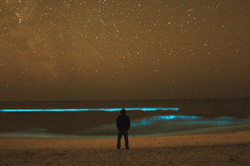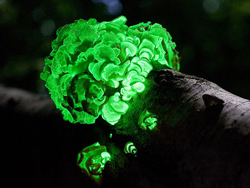The Wonder of Bioluminescence: Organisms that Glow
Many beaches and waters glow blue or green thanks to marine organisms that create their own light as a result of a biochemical reaction.

The above photo, taken by photographer August Bach at Grayton Beach, shows "waves" of glowing blue light cast by bioluminescent organisms along the Florida shore.
The image below shows the startling bioluminescence of the Panellus Stipticus fungus.

Visitors to the American Museum of Natural History in New York City can see firsthand photos of bioluminescence in the "Creatures of Light: Nature's Bioluminescence" exhibit, which includes amazing photographs of bioluminescence taken by Japanese photographer Tsuneaki Hiramatsu.
(Images: Grayton Beach, courtesy of August Bach. Fungus, Wikipedia. )
When I was a kid, I remember hearing exotic tales from other kids who went somewhere on one school break or another and saw waters and beaches that glowed. The image of neon green waters created a lasting impression in my head. I doubt, at the time, that I understood the difference between bioluminescence, fluorescence, phosphorescence, and chemiluminescence. All I knew was that they said the water glowed. Growing up relatively land-locked in a mountainous area, the idea of glowing waters was certainly something mystical—maybe similar in mystique to the Northern Lights. If you don't live somewhere where you can actually "see" the aurora borealis, it's hard to fully comprehend what it must be like to witness such a display firsthand.
Today, though I'm no longer landlocked, I still haven't been anywhere with glowing waters, and my fascination with photos of glowing coastlines—and amazing spectral displays—remains strong. I am sure the aura of wonder that surrounds bioluminescence partly explains my response to the wonder of Pandora in the Avatar movie. How can you watch such a beautiful, luminous, natural terrain and biosphere and not catch your breath? Though Pandora in the Avatar is fictional, real hotbeds of bioluminescence can be found around the world. Bioluminescent (or "Mosquito") Bay in Vieques, Puerto Rico and Vaadhoo Island in the Maldives, are two notable destinations for viewing marine bioluminescence. In the continental U.S., pools of bioluminescence can be found on both coasts.
I haven't been in the right place at the right time to walk across a glowing stretch of sand, but you may not have to travel far to find examples of bioluminescent organisms. My fifth grade student recently participated in a fieldtrip to NatureBridge at Golden Gate (formerly the Marin Headlands Institute), and a nighttime beach exploration gave him a firsthand appreciation of bioluminescence and phytoplankton.
Self-Contained Systems
What's going on when you see organisms that glow, blink, or appear to light up? Bioluminescence.
Bioluminescence is the production and emission of light by a living organism. A bioluminescent organism is one that lights up by virtue of a biochemical process. An example of chemiluminescence, bioluminescence occurs when a chemical reaction takes place between an organic substrate, luciferin, and an enzyme, a luciferase, which serves as a catalyst. The oxidation of the luciferin by the luciferase results in an inactive oxyluciferin and a visible light. Remove the oxygen, and the light goes out. In some organisms, the luciferin and a catalyzing enzyme (the equivalent of the luciferase) are bound together, along with oxygen, into what is called a photoprotein. The addition of ions, often calcium, turns 'on' the photoprotein. In all cases, the light is considered a cold light as it doesn't produce heat. And, colors of bioluminescence vary by organism. Green and blue are common, but many organisms produce other colors of light.
While marine-based organisms that glow often steal the show when it comes to photos like the ones featured in this National Geographic photo collection, many types of organisms bioluminesce, including single cell organisms, bacteria, fungi, earthworms, beetles, fish, jellyfish, and even squid. If fireflies, or "lightning bugs," are common in your area, then you've seen bioluminescence in action as the insects rise from the grasses at dusk, appearing to blink on and off like small lights as they drift through the night.
Making Connections
Students curious about bioluminescence can find many different questions to ask and angles to explore. Why do these organisms bioluminesce? Are the chemical reactions cyclical? Are they triggered in response to something? How long does the glow last? Are there conditions that negatively or positively influence the biochemical process?
During firefly season, students not near a bioluminescent beach, may be able to develop a custom science project to turn the timeless pastime of catching lightning bugs in a jar into a novel science investigation of bioluminescence. But another approach to studying bioluminescence, independent of your geographic location, is to use marine dinoflagellates. Dinoflagellates are single-cell organisms that use whip-like tails for movement. Many dinoflagellates are bioluminescent. By cultivating dinoflagellates at home, you can conduct your own first-hand studies of marine bioluminescence. In the Bioluminescence: Investigating Glow-in-the-Dark Dinoflagellates biotechnology Project Idea, students can study culture samples of marine dinoflagellates, either Pyrocystis lunula or Pyrocystis fusiformis, to examine the relationship between light and dark and the organism's bioluminescence.
Categories:
You Might Also Enjoy These Related Posts:
- Plastics and Earth Day - Science Projects
- Arduino Science Projects and Physical Computing
- 10+ Robotics Projects with the BlueBot Kit
- 5 STEM Activities with Marshmallow Peeps
- March Madness Basketball Science Projects: Sports Science Experiments
- Women in STEM! More than 60 Scientists and Engineers for Women's History Month
- Explore Artificial Intelligence and Machine Learning with Student AI Projects
- 10 Reasons to Do the Rubber Band Car Engineering Challenge









